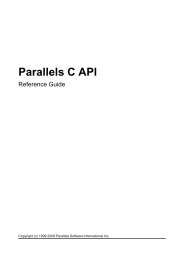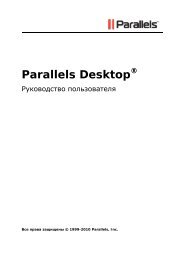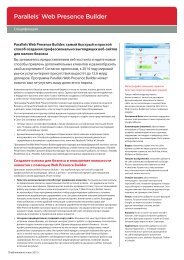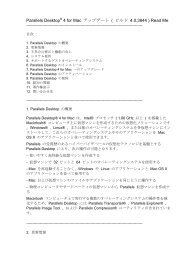[PDF] Parallels Server 5 Bare Metal
[PDF] Parallels Server 5 Bare Metal
[PDF] Parallels Server 5 Bare Metal
You also want an ePaper? Increase the reach of your titles
YUMPU automatically turns print PDFs into web optimized ePapers that Google loves.
What are Disk Quotas?<br />
Managing Resources<br />
Disk quotas enable system administrators to control the size of Linux file systems by limiting the<br />
amount of disk space and the number of inodes a Container can use. These quotas are known as<br />
per-Container quotas or first-level quotas in <strong>Parallels</strong> <strong>Server</strong> <strong>Bare</strong> <strong>Metal</strong>. In addition, the <strong>Parallels</strong><br />
<strong>Server</strong> <strong>Bare</strong> <strong>Metal</strong> software enables the Container administrator to limit disk space and the number<br />
of inodes that individual users and groups in that Container can use. These quotas are called peruser<br />
and per-group quotas or second-level quotas.<br />
By default, first-level quotas on your server are enabled (which is defined in the<br />
/etc/vz/vz.conf configuration file), whereas second-level quotas must be turned on for each<br />
Container separately (in the corresponding Container configuration files). It is impossible to turn on<br />
second-level disk quotas for a Container if first-level disk quotas are off for that Container.<br />
<strong>Parallels</strong> <strong>Server</strong> <strong>Bare</strong> <strong>Metal</strong> keeps quota usage statistics and limits in<br />
/var/vzquota/quota. - a special quota file. The quota file has a special flag<br />
indicating whether the file is “dirty”. The file becomes dirty when its contents become inconsistent<br />
with the real Container usage. This means that when the disk space or inodes usage changes<br />
during the Container operation, these statistics are not automatically synchronized with the quota<br />
file, the file just gets the “dirty” flag. They are synchronized only when the Container is stopped or<br />
when the server is shut down. After synchronization, the “dirty” flag is removed. If the server has<br />
been incorrectly brought down (for example, the power switch was hit), the file remains “dirty”, and<br />
the quota is re-initialized on the next Container startup. This operation may noticeably increase the<br />
server startup time. Thus, it is highly recommended to shut down the server properly.<br />
Disk Quota Parameters<br />
The table below summarizes the disk quota parameters that you can control. The File column<br />
indicates whether the parameter is defined in the global configuration file (G), in the Container<br />
configuration files (V), or it is defined in the global configuration file but can be overridden in a<br />
separate Container configuration file (GV).<br />
Parameter Description File<br />
DISK_QUOTA Indicates whether first-level quotas are on or off for all Containers or for an<br />
individual Container.<br />
DISKSPACE Total size of disk space the Container may consume, in 1-Kb blocks. V<br />
DISKINODES Total number of disk inodes (files, directories, and symbolic links) the<br />
Container can allocate.<br />
QUOTATIME Grace period for the disk quota overusage, in seconds. The Container is<br />
allowed to temporarily exceed its quota soft limits for no more than the<br />
QUOTATIME period.<br />
QUOTAUGIDLIMIT Maximum aggregate number of user IDs and group IDs for which disk<br />
quota inside the given Container will be accounted. If set to 0, the UID and<br />
GID quota are disabled.<br />
GV<br />
V<br />
V<br />
V<br />
117


![[PDF] Parallels Server 5 Bare Metal](https://img.yumpu.com/18850617/117/500x640/pdf-parallels-server-5-bare-metal.jpg)
![[PDF] Parallels Desktop® 7](https://img.yumpu.com/18852044/1/190x245/pdf-parallels-desktopr-7.jpg?quality=85)

![[PDF] Parallels Python API Reference](https://img.yumpu.com/18850615/1/190x245/pdf-parallels-python-api-reference.jpg?quality=85)








![[PDF] Parallels Python API Reference](https://img.yumpu.com/18850529/1/190x245/pdf-parallels-python-api-reference.jpg?quality=85)

